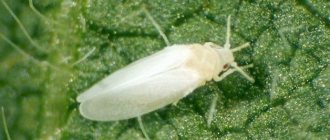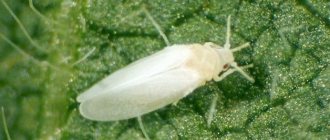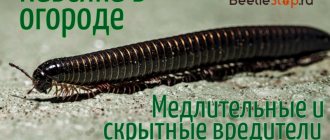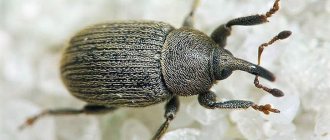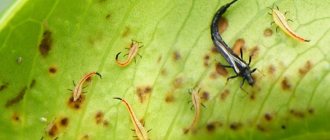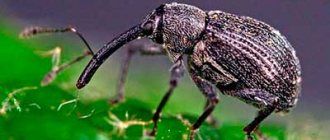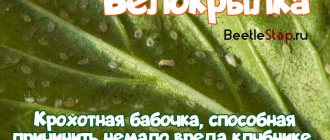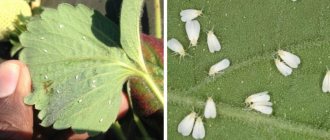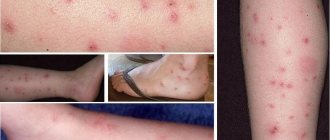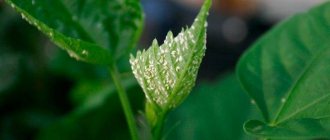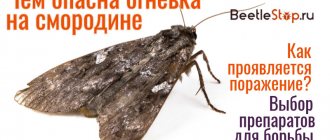Small insects can cause great damage to plants. If pests are detected in time, you can quickly and effortlessly preserve the crop. But white midges on strawberries that are not removed in time can cause irreparable damage.
These small insects are called whiteflies. They lay larvae on the bottom of the leaves, which begin to eat the plant itself. It is the larvae that harm the plant, not the adults.
The midges themselves are practically invisible, because... they reach 1.5 mm in size. This makes them very difficult to see. But if you find a huge accumulation of midges as small as dust, then you need to take urgent measures to save green spaces.
In addition, small holes in the leaves can be one of the signs of pests.
What does whitefly look like on strawberries and how to fight it?
The whitefly is a rather insidious insect that loves to settle on a wide variety of garden crops. Strawberries are no exception, on which whiteflies can be found quite often. As a rule, based on external characteristics, it is almost impossible to confuse this insect with other pests. In this article, we will take a closer look at the description of the whitefly, find out why it is so dangerous, and also consider the most effective methods of combating it not only with the help of chemicals, but also with proven folk methods.
Prevention
The practice of growing strawberries shows that the more attention you pay to this berry crop, the fewer misfortunes it suffers.
And yet, the best way to preserve the harvest is timely prevention. What does that require?
- Maintain distance when planting strawberry bushes.
- Ensure good ventilation of the greenhouse.
- Do not water or spray plantings in conditions of high humidity.
- Use biostimulants and biological pest control methods.
- Remove dried plants, weeds, and dig up the soil before wintering.
- Disinfect greenhouse premises.
Description
The whitefly is a small insect of white and yellow color. From a distance, whiteflies look like small white midges or moths, many attribute this to the similarity of their wings. As a rule, these insects do not reach more than 3-4 mm in length, and many specimens are even less than 1.5 mm.
Whiteflies have four wings, covered with a special coating that resembles something like flour or light dust. Having familiarized yourself with photographs and pictures of these insects, in the future it will not be difficult to identify this parasite on a flower or garden crop.
White flies actively feed on the sap of plants, as a result of which the latter gradually lose their strength and die. Very often, the appearance of whiteflies at first may not be noticeable; when searching for insects, it is very important to also inspect the lower surface of plant foliage.
As a rule, whiteflies actively appear in the second half of summer.
Today, several species of this insect are known, for example, there is a greenhouse whitefly, citrus, strawberry and even tobacco. It is worth noting right away that these small pests, regardless of what species they belong to, are dangerous for any garden crops. Everyone needs to be poisoned without exception. They will not bring any benefit. Strawberries are usually attacked by a species of strawberry whitefly.
White flies multiply very quickly, and therefore just one infectious plant can pose a threat to the entire garden. It is recommended to get rid of the parasite as early as possible. That is why any new plants should not be placed in the garden immediately, but should be observed for some time.
Otherwise, the entire crop may suffer.
What factors provoke the appearance of a pest?
High temperature and high humidity levels are two negative factors that adversely affect crispy vegetables. It is a mistake to think that an insect lives only in greenhouse conditions, where a closed ecosystem exists. In open ground, white midges can make themselves felt. The adult individual prefers the juice of the plant - its favorite food. The more actively the pest satisfies hunger, the faster the bush dies.
You may be interested in:
Fighting spider mites in a greenhouse on cucumbers If you are interested in the question of how to get rid of spider mites on cucumbers in a greenhouse, you should familiarize yourself with folk...Read more...
The second problem caused by the activity of the parasite is the secretion or dew it secretes. A pathogenic fungus multiplies in it. After 24-30 hours, the cucumber seedlings become sick. Productivity decreases. The third problem is that midges need leaves to lay eggs. They are located along the inside. Less often, the masonry is noticeable on the stem or at the base.
On a note! Not only heat and high humidity levels can provoke the appearance of a parasite in an area. White-winged midge eggs can be introduced if you take untested planting material. The source of problems will be the neighbor's garden, the owner of which does not engage in prevention.
Signs of appearance
It is not known for certain why white flying flies appear in the garden or garden. Many experts do not have a consensus on this matter. Very often, the appearance of the insect is due to the fact that strawberry bushes are planted close to each other, the optimal temperature regime is not maintained in the greenhouse, there are no preventive measures, and there is no proper fertilization of the plants.
The main signs of the appearance include white midges flying over strawberries, very reminiscent of moths, as well as the following visual characteristics.
As a rule, if a whitefly has actively multiplied in strawberry bushes, it will be noticeable to the naked eye. If you do not take immediate measures to get rid of the insect, you may be left without a harvest. That is why it is recommended to treat the bushes with safe decoctions or infusions in advance.
It happens that whiteflies infest fruit-bearing strawberries. It is quite possible to notice signs of this, especially if you regularly inspect the plants, but in this case only safe or folk remedies are suitable for treatment, then everything will be fine with the berries.
If the insect appears after the harvest, then you can use biological products without any problems, and if there are a lot of insects, then chemical ones.
What factors provoke the appearance of a pest?
High temperature and high humidity levels are two negative factors that adversely affect crispy vegetables. It is a mistake to think that an insect lives only in greenhouse conditions, where a closed ecosystem exists. In open ground, white midges can make themselves felt. The adult individual prefers the juice of the plant - its favorite food. The more actively the pest satisfies hunger, the faster the bush dies.
You may be interested in: Fighting spider mites on cucumbers in a greenhouse If you are interested in the question of how to get rid of spider mites on cucumbers in a greenhouse, you should familiarize yourself with folk...Read more...
The second problem caused by the activity of the parasite is the secretion or dew it secretes. A pathogenic fungus multiplies in it. After 24-30 hours, the cucumber seedlings become sick. Productivity decreases. The third problem is that midges need leaves to lay eggs. They are located along the inside. Less often, the masonry is noticeable on the stem or at the base.
On a note! Not only heat and high humidity levels can provoke the appearance of a parasite in an area. White-winged midge eggs can be introduced if you take untested planting material. The source of problems will be the neighbor's garden, the owner of which does not engage in prevention.
Why is it dangerous?
Since white midges feed on plant juices, it all ultimately comes down to the fact that the plants begin to die from lack of nutrients. In addition, large colonies of midges begin to fly to other neighboring plants and even trees.
As a result of the appearance of sticky dew, which has already been mentioned, the process of photosynthesis is disrupted. The leaves do not receive proper nutrition, spots appear on them, they begin to curl, and then completely wither. As a result of weakening, in addition to the whitefly itself, other insects can attack the bushes, but most often already weakened bushes begin to get sick under the influence of various fungal and other diseases. In addition, the whitefly itself carries various diseases.
Despite its very modest size, this pest can cause a lot of trouble to plants and future harvests.
But, knowing what the enemy looks like in person, you can very quickly identify and eliminate him.
What kind of midges grow on personal plots?
The term summer midge can hide two types of pests:
- black midge, which summer residents call melon aphids;
- white midge, better known as whitefly.
Representatives of both species are very prolific, harmful, and controlling them can be very difficult.
black midge
This type of pest includes two subspecies of midges: with and without wings. They live mainly in tomato beds, sitting on the bushes in a dense layer. As was already said, such midges reproduce very quickly and also quickly disperse throughout the garden. Damaged bushes wither and die over time.
To prevent black midges from entering the garden, experienced summer residents advise planting plants around the perimeter of tomato beds that will attract its natural enemies: wasps, ladybugs, hoverflies and lacewings. In addition to fragrant herbs, it is advisable to plant dill, garlic, onions and calendula on the site - midges really do not like their aroma, and therefore rarely settle near them. It also wouldn’t hurt to inspect the area and destroy any anthills found on it. This measure is necessary due to the fact that ants feed on the secretion secreted by black flies, and therefore protect them from other insects.
White midge
White midges are found mainly in greenhouses. She settles on the back of the leaves, where she lays her eggs. Over time, larvae emerge from the eggs, which, feeding on plant juices, cause great harm to them.
Determining that a crop is infected is quite simple - all you have to do is pay attention to its appearance. On plants affected by white midges, the leaves begin to curl, the fruits ripen unevenly and many become white inside, a whitish coating is visible on the foliage, which turns black after a while, and despite proper watering, the green parts of the bush gradually turn yellow. In order to make sure that it was the white midge that attacked the plant, you just need to touch it, and the pests on it will immediately fly away
In order to make sure that it was the white midge that attacked the plant, you just need to touch it, and the pests on it will immediately fly away.
Since the white midge loves moisture very much, it rarely appears in the garden. This parasite lives mainly in greenhouses, where conditions that are comfortable for it are always present. And in order to prevent the spread of the pest, it is necessary, first of all, to plant the seedlings not very densely
In addition, in a greenhouse it is very important to ensure good air circulation and to strengthen the beds with fertilizers.
Whitefly pest: fight, folk remedies, how to get rid of small white midges
Whiteflies or Aleyrodidae are a family of very small homoptera insects with a waxy coating on their wings. The source of their life is plant sap, which they absorb in quantities much greater than their nutritional needs. This is precisely the main reason for the death of crops.
Also, as a result of such excessive eating, the whitefly secretes the so-called “dew”, which, settling on the leaves, contributes to the formation of sooty fungus. And, here it, in turn, interferes with their normal air exchange and photosynthesis, as a result of which the plants begin to become covered with a sticky crust, turn black, and then die.
But that's not all. Whiteflies are also carriers of a variety of diseases that can simply infect a healthy crop. In general, this little white midge causes global harm, combining a large number of threats to diseases and plant death, acting both in open ground gardens, in greenhouses, and even at home. In order to successfully fight whiteflies, it is necessary to use more than one method of protection, destruction and prevention. And the most important thing is to act in a timely manner; if the process is delayed, it is very difficult to get rid of this pest.
Signs of whitefly damage to a plant
It is quite simple to identify a whitefly - it is small, maximum 1.5-5 mm in size, white, most often with a yellowish tint, similar to a moth. When you touch the affected plant, the midges fly away (as do psyllids). But you also need to pay attention to the larvae that it lays - they are much, much more difficult to detect - they are oval in shape, green-transparent in color, and their size does not exceed 0.2-3 mm (depending on the species).
The leaves of the plant that are infected have spots of white coating on their surface. The whitefly itself hides on the back, invisible side of the leaf, and if you turn it over, the midges will immediately fly away. You can also see yellowed leaves that soon fall off - this is also the work of the whitefly.
The fight against whiteflies is also complicated by the fact that they reproduce very quickly. If measures are not taken in a timely manner, it can destroy quite large areas of crops. During her entire life, which is a month, she can lay about 130 eggs. And after 5-7 days, the eggs turn into larvae, then, after 2 weeks, into nymphs, and then into adults.
Whitefly larvae during their development are very resilient: they are not afraid of pesticides and other similar drugs. Therefore, it is practically useless to fight them during this period. In open ground, female pests lay eggs only in the spring, but with heated greenhouses it is more difficult - there is a comfortable climate for this process almost all year round. Therefore, it is in the greenhouse that the whitefly has ideal conditions for reproduction; there it can grow up to 15 generations in a year. Can you imagine? Just creepy...
Who are these snow-white midges?
When snow-white midges or strawberry whiteflies appear on strawberries, you need to sound the alarm.
This is the most terrible and worst enemy of the plant, although in appearance it is quite pretty. Most often it is hidden on the inside of the petal. It can be confused with a moth or a small butterfly. If you touch its wings, you can see that they are covered with a snow-white waxy coating. This insect has two rather long wings that are not so wide. It is small in size, not more than 3 mm. The whitefly is afraid of direct sunlight, so it hides in the shade of leaves. This is a very prolific insect, and in one spring-summer season 4 generations are replaced. One female whitefly can lay up to 20 eggs, from which larvae will later appear; they are quite active. These larvae attach themselves to the leaf and begin to feed on its juices. During the period of degeneration of the larvae into an adult, their whiskers and legs disappear.
Fighting whitefly on strawberries: effective methods
The whitefly on strawberries is a pest that literally sucks out the vital juices of this plant. Therefore, when it appears on the bushes, the plantings begin to suffer: their development is slowed down, they become susceptible to diseases, and this ultimately negatively affects the taste and quantitative characteristics of the crop. Therefore, in order to get large and sweet berries, you need to start fighting whiteflies as early as possible.
Preparations for whiteflies
Many people consider the right way to control pests to be the use of chemicals that are sold in specialized stores. When used correctly and in accordance with the dosage, they are completely safe for plants and effective against pest infestation.
However, preparations for whiteflies can be harmful to people, so treatment must be carried out using personal protective equipment:
"Teppeki" for whiteflies is a systemic insecticide. Water-dispersible granules of this drug, entering the insect’s body, act in such a way that the pest stops feeding and, after some time, dies. The duration of the drug is 30 days. When treating whiteflies with this drug, you need to follow some rules. For example, the preparation of the solution should be done on the same day that the treatment will be carried out. The granules are dissolved in warm water at the rate of 1 g per 2-3 liters. Spraying should be carried out in dry weather in the morning or evening. If the procedure is carried out in a greenhouse, then after finishing the work it must be well ventilated.
“Aktara” for whiteflies is used quite often because it is a strong systemic insecticide. The drug can be used for watering or spraying. In the first case, 1 g of product will be required per 10 liters of water. When preparing a solution for spraying, the concentration of the drug is much less: 1 g of the drug needs to be dissolved in only 1.25 liters of water. This amount should be enough to process 30-35 plants. To achieve complete disappearance of butterflies, spraying should be carried out every 2 weeks (3-4 times in total).
"Fitoverm" is also often used against whiteflies. The instructions for using the drug say that this is a contact-intestinal insectoacaricide, in addition to combating whiteflies, it can be used when infecting plants with aphids and various types of mites. Humidity and air temperature determine how long after treatment the plantings will be protected from pests. Typically this period varies from 5 to 15 days. In greenhouse conditions, protection lasts longer - 2-3 weeks.
“Iskra Zolotaya” is a modern drug used to destroy whiteflies, aphids, midges, and the Colorado potato beetle. The drug is considered highly effective and has a long shelf life. After treating plantings with Iskra Zolotoy, even those insects that survived earlier, after being treated with another drug, die. The death of whiteflies after spraying with this product occurs within 1-2 days.
Pest Information
Whiteflies are the name of a large family of insects, which includes over 1,500 species. Several dozen of them are widespread in the territory of the former USSR and pose a threat to garden and vegetable plantings. This family got its name because of the characteristic waxy coating on the wings of its representatives.
Externally, whiteflies look like tiny moths
These are small insects: the length of adult individuals ranges from 1.5 to 5 mm. They feed on plant juices, and at the same time draw them out in large volumes, exceeding the required amount for nutrition.
If measures are not taken in time, the parasitic activity of whiteflies will ultimately lead to the death of the plantings.
Pests of garden strawberries and control methods
Pests of garden strawberries and methods of control
Based on the nature of the damage caused, strawberry pests can be divided into groups:
- Nematodes – strawberry, stem, chrysanthemum. They feed on plant juices, which leads to darkening, swelling of petioles, curling of leaves, and tissue death. They are active in May–June.
- Mites – strawberry mites, spider mites. They “settle” at the base of the bushes and suck the juices out of the plant. Infection occurs, then leaves turn yellow and die. The first type of mites is activated when there is high humidity, the second - when there is a lack of it.
- Beetles – weevils, leaf beetles, bronze beetles. The first ones affect strawberry buds, the second and third ones affect the foliage. They are active at different times of the year.
- Slugs and snails eat strawberry fruits and become active at night or in rainy weather.
- Larvae of the May beetle, wireworm, potato cutworm, weevil, etc. They feed on the root system of the plant. Mainly active during flowering and fruiting of strawberries.
- Aphids – spread viral diseases and produce honeydew. As a result, the leaves of the plant become deformed and turn yellow. Particularly active with the appearance of fruits.
- Caterpillars of the moth armyworm, whiteflies, leaf rollers . Most parasitize the foliage of plants; cutworm caterpillars bite into the roots.
- Ants build nests in the roots of the plant and plant aphids on the leaves. This leads to a decrease in fruiting and the death of the bush.
- Birds - eat and spoil the fruits of the plant, are active during the fruiting period.
Weevil
Weevil
A black beetle with a long proboscis, up to 3 mm long. The body is covered with gray stripes. It overwinters under fallen leaves, and in the spring it gnaws holes in strawberry leaves. Female weevils are dangerous for the crop because they lay eggs in the buds, gnawing on the stalk. This leads to wilting, buds falling off, and reduced yield.
To prevent the appearance of weevils, the soil around the bushes and between the rows is loosened. The fight against the parasite is carried out by the following means:
- Chemical (Karbofos, Kinmiks, Inta-Vir, Fitoverm) and biological (Antonem, Nemabakt) drugs. They should be used to spray strawberries against pests twice: when the buds open and 14 days before flowering. If necessary, repeat the procedure in the summer. The drug is prepared according to the instructions.
- Baking soda solution – 2 tbsp. l. powder per 10 liter bucket of water. Treatment can be carried out during flowering.
- Wormwood decoction: pour boiling water (10 l) over 1 kg of herb and boil, add crushed laundry soap (40 g). Leave for 12 hours, use for spraying.
- A mixture of 3-4 caps of birch tar, liquid soap and 10 liters of water. Spraying is carried out in the morning in dry weather.
- Tobacco dust, ash. They are sprinkled in the middle of the bush in the spring to repel pests.
- During the formation of berries, the fight is carried out with the following compounds:
- 5 g of potassium permanganate per 10 liters of water;
- 2 kg of ash (wood) per bucket of water;
- 10 g mustard powder per 10 liters of liquid.
Strawberry mite
Strawberries affected by the strawberry mite
This insect is about 1-2 mm in size. The mite parasitizes the lower part of the petioles, the buds of leaves, and sucks the juices out of strawberries. This leads to deformation, yellowing, and wilting of the foliage. The bushes develop poorly and produce a poor harvest. The mite becomes active in mid- to late summer, especially with high humidity.
For prevention, strawberry bushes are immersed in water (46 °C) for 15 minutes before planting. Methods of pest control:
- In the spring, after the snow has melted, the bushes are doused with hot water (60 °C, no higher).
- When there is a small accumulation of ticks, biological preparations are used - Fitoverm, Akarin, Kleschevit. They are diluted in a ratio of 1.5–2 ml of the substance per bucket of water (10 l). The crop is processed up to 4 times per season.
- When biological products are ineffective, chemicals are used: Karate Zeon (5 ml / bucket of water), Karbofos (3 tbsp / 10 l of liquid), chloroethanol (15–30 ml / 10 l of water). Spraying is carried out after harvesting or before foliage grows.
- As a folk remedy, spray with infusions of onion peels (200 g), onions (100 g) or garlic (200 g). Any of the ingredients is poured into 10 liters of boiling water, cooled, and filtered. Treatment is carried out 4 times per season.
Strawberry leaf beetle
Strawberry leaf beetle
The pest is a brown beetle, up to 3–4 mm in size. The larvae are yellow with a brown head. The leaf beetle parasitizes on the underside of leaves, where females lay eggs. Bugs eat the pulp, the core of the leaves. As a result, the strawberry bushes wither and fruiting stops.
The fight against the leaf beetle is carried out using the following methods:
- For prevention, the ground around the bushes is weeded to remove weeds and sprinkled with tobacco dust in the spring.
- After fruiting is completed, the soil is loosened to eliminate the parasite pupae.
- Twice before the start of flowering, the lower part of the strawberry foliage is sprayed with pesticides Metafos, Nurell-D, Karbofos, Corsair.
Spider mite
Strawberries affected by spider mites
The presence of this pest of strawberries is indicated by a large number of cobwebs. In spring and summer, insects are yellow-green in color, and by autumn they turn brown. They feed on plant sap. Methods to combat spider mites:
- Planting phytosailus on the beds - a mite that destroys other mites.
- Compliance with crop rotation and agricultural technology.
- Planting phytoncides between rows: calendula, garlic, marigolds.
- Use for spraying folk remedies: infusions of tobacco, garlic, onions, hot pepper.
- Carrying out treatment with drugs:
- 20 days before harvest - Actellik (6 ml per 5 liters of liquid);
- during berry ripening and harvesting - Actofit (6 ml per liter of liquid);
- after flowering - Apollo (2 ml per 5 liters of water).
May beetle larvae
May beetle larvae on strawberries
These are large brown insects. They feed on humus and strawberry roots. As a result, the plant withers and dies. The fight against cockchafer larvae is carried out as follows:
- During the flight of beetles, traps are set for them - bottles with sweet water. This prevents the appearance of new larvae in the soil.
- Beans, clover, and beans are sown on plantations. Urea and ammonium nitrate are added to enrich the soil with nitrogen, which the larvae cannot tolerate.
- Parasites are collected by hand by digging up wilted bushes and examining the lump of earth on the roots.
- Water the beds abundantly - the larvae do not like wet soil.
- Water the plants using folk remedies:
- onion infusion: 100 g of onion peel is poured into a bucket of warm water, left for 3-5 days;
- iodine solution: 10–15 drops of iodine are diluted in 10 liters of liquid.
- Chemicals used for root watering:
- Aktaru (1.4 ml / 0.7 l of water) – after harvesting;
- Antikhrushch (100 ml / bucket of liquid) – after picking the berries.
Strawberry whitefly
Whitefly on strawberries
The whitefly butterfly has a body length of up to 1.5 mm. Her wings are covered with a waxy coating. The pest settles in strawberry plantations located in the shade. It feeds on the sap of young leaves. To fight, you can use the following methods:
- Move the strawberry beds to a sunny area.
- Weed weeds in a timely manner and clear the beds of fallen leaves.
- Wash off the insect with water and immediately loosen the soil by 2–3 cm.
- Place traps in the form of a sheet of plywood, painted with yellow paint and greased with Vaseline.
You can wipe large leaves and spray small ones with the following compounds:
- a solution of water and laundry soap (ratio – 6:1);
- infusion of 150 g of garlic (chopped) and a liter of liquid. The resulting mixture must be filtered, diluted with water in a ratio of 6 ml of composition/1 liter of liquid;
- yarrow infusion: scald 80 g of crushed plant with boiling water, pour in 1 liter of liquid, leave for 24 hours.
List of drugs and recipes for treating plants:
- at the peak of whitefly appearance (but no more than 4 times per season) – Actellik (1 ampoule/1 liter of water);
- 1 time when an insect appears - Confidor (0.1 ml/1 l of liquid);
- twice with an interval of 7–10 days - Verticillin F (25 ml/1 l of liquid);
- 2 times at weekly intervals – Pegasus (2 ml/1 l of liquid.
Nematodes
Types of nematodes
These are transparent worms that suck the juice from the plant and release their enzymes inside. The leaves darken, become deformed, the petioles become lilac, the peduncles thicken, and the berries become smaller. Swellings appear on the roots, first the plant cells die, and then the strawberry bushes.
There are no special remedies against nematodes. They are fought in the following ways:
- Before planting, strawberry bushes are immersed in boiling water (50 °C) for 15 minutes.
- They observe crop rotation and weed the beds in a timely manner.
- Marigolds and calendula are planted between the rows.
- Affected plants are destroyed, and the soil after them is treated with solutions of iron sulfate (5%), formaldehyde (4%) or bleach.
- In the fall, sprinkle the soil with Akarina powder to combat wintering pests.
Medvedka
Mole cricket pest
This is a brown insect with a body length of up to 6 cm. The mole cricket lives in the ground and lays eggs there. The larvae appear in spring or early summer and feed on plant roots. The presence of mole crickets can be determined by the wilting of plants. Insect control methods:
- Attracting birds - rooks, starlings, crows. They eat adults and larvae.
- Planting marigolds, chrysanthemums, and calendula next to strawberry plantations.
- Luring out the insect with a soap solution. It is poured into openings on the ground surface.
- Using bait - jars of honey buried up to the neck in the ground.
- Destruction using grain poisoned with drugs. It is buried shallowly in the ground. Zolon, Marshall, Bazudin, Aktara are suitable for this purpose. The same preparations are used for drip irrigation of the soil.
Aphid
Aphids
These are small insects of black, brown or green color. They multiply quickly and settle in large colonies on the foliage, petioles, and flower stalks of the plant. Their presence leads to deformation, yellowing of leaves, and stopping the development of buds. Methods for controlling aphids:
- Attracting small birds, wasps and ladybugs.
- Treatment with folk remedies: soap solution, tobacco decoction, tincture of hot pepper.
- Spraying with chemicals Nurell-D, Shar Pei, Karate, Zolon. It is carried out before the appearance or after picking the berries.
Slugs
Slugs Shellfish
come in light gray to brown shades. Slugs appear in heavily dense plantings and damp places. They feed on strawberries, buds, leaves and petioles, and carry fungal infections. Ways to combat slugs:
- Collection by hand.
- Mulching beds with sawdust and pine needles.
- Weeding of plantations, garbage collection.
- Distribution of the preparations Thunderstorm, Slug Eater, Anti-slug, Ulicide over the soil surface.
- Installation of traps, bait: cabbage leaves, boards, cans of corn flour. Once the slugs have accumulated, they are destroyed.
- Watering the rows with solutions of mustard (10 tsp / 1 liter of liquid) and brilliant green (10 ml / 10 liters of water).
What is the danger to strawberries?
Due to the abundant feeding of plant juices in large quantities, not all of their volume is absorbed in the whitefly’s body. Therefore, the insect secretes a whitish liquid, similar to dew, which is located on the leaves. This substance is a favorable environment for sooty fungus to live.
Therefore, a gardener whose strawberries have been attacked by a whitefly will face additional problems. After all, the fungus disrupts the flow of air to the leaf plates of the plant and interferes with the vital course of photosynthesis. The result will be the formation of a sticky crust on the plants, blackening and death of the green part. Whiteflies are also carriers of diseases.
Despite its small size, this parasite causes significant damage to strawberry plantings. But, knowing what whitefly looks like on strawberries and how to fight it, you can save the plants and the future harvest. The main thing is to take the necessary measures in time.
Strawberry diseases and treatment
Pests cause a lot of different problems to the garden:
- the risk of developing various diseases increases;
- frost resistance decreases (does not tolerate winter well and may die);
- the tangles weaken;
- the plant dies.
To prevent this from happening, every gardener, even an amateur, must, before planting a plant, take care of its further prosperity and protect the strawberries from the effects of harmful factors on them.
Very often, gardeners use traditional medicine to combat various insects, which do not contain substances harmful to the human body. But before we begin to consider folk remedies, it is necessary to deal with the parasites that “attack” strawberries, there are many of them and each individual case requires its own approach.
Strawberry pests:
- weevil;
- aphid;
- strawberry whitefly;
- mite;
- mole cricket;
- slugs
Let's take a closer look at each type of pest, how they form, develop and, of course, how to fight them using traditional methods.
Ways to fight
The fight against the parasite is complicated by its rapid reproduction rate. The whitefly does not live long - about a month, but during this time it manages to lay more than 130 eggs. Larvae will appear after 7 days, and adults that continue to reproduce will appear after 3-4 weeks.
But, if strawberries grow in open ground, then the whitefly lays eggs only in the spring months. In a greenhouse, this happens almost all year round, during which time up to 15 generations of the pest appear. Another difficulty is associated with the resistance of the larvae to chemicals, so only adult individuals can be affected.
Chemicals against whiteflies: top 5
Most chemicals available for whitefly control kill them when they enter the digestive system (gut action). The most effective and popular products for use on strawberries include:
All these drugs should be used strictly in accordance with the instructions for use.
Flea remedies can also help: shampoos and sprays with the active ingredient fipronil. They are sold in veterinary pharmacies. The leaves are treated with a solution of shampoo in water, and the spray is sprayed onto the soil around the bushes or mulch. Anti-flea drugs are used as adjuvants.
Processing rules
Considering that pesticides destroy only adult individuals and have virtually no effect on eggs, it is necessary to carry out multiple treatments as flying whiteflies appear. In addition, intestinal insecticides have an effect only when parasites feed, and once will not be enough, because insects feed at different times. Four treatments with a break of 3, 5 and 7 days are enough.
At the same time, with each procedure, the concentration of chemicals should be reduced so as not to harm the plants and not make its future fruits harmful to human health.
The use of insecticides designed to combat whiteflies can be combined with the use of drugs of another type: stimulants of plant growth and immunity, which improves their resistance to stress. For example "Bud".
Other important rules for treating strawberries with an insecticide against whiteflies:
If you take these recommendations into account, then the fight against whiteflies with insecticides will be successful and safe.
Biological method
An alternative to the use of chemicals is the use of biological agents. One of them is the deliberate placement of other parasites in strawberry beds - for example, encarsia or macrophus bugs. Feeding on whitefly larvae, they are harmless to plantings. You can buy such insects in a biological laboratory or large garden and vegetable farms. When the parasites complete their mission, they leave the strawberry.
Biological means of getting rid of whiteflies include the insecticide "Verticillin Zh", which contains fungal spores. It has the ability to penetrate the body of the whitefly and infect its organs, leading to death.
Biological enemies of whiteflies
White midges on Victoria and other strawberry varieties are destroyed with the help of natural enemies of whiteflies. These include:
- Encarzia is a small parasite that lays eggs in the body of midges, like a wasp. The mature larva gnaws through the body of the host and climbs out. Such insects are purchased from specialized companies.
- Ladybug - she preys on aphids and whiteflies.
- The lacewing is a predator that eats smaller insects.
- The Geocoris bug specializes in eating midges.
